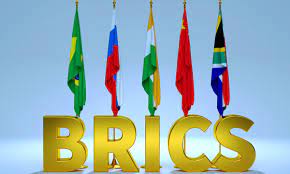
A Relevant BRICS: Reimagining Global Economic Reform
By Soumya Bhowmick
In the current global economic landscape, the trajectory of multilateral institutions is undergoing a pivotal shift, and the BRICS alliance is a crucial player in this transformation. As we delve into the realms of trade, investment, and finance within BRICS, we find ourselves navigating the complexities of an ever-evolving geo-economic and geopolitical paradigm.
The origins of the BRICS initiative can be traced back to the early 2000s when Brazil, Russia, India, and China formed a loose consortium known as BRIC. However, in 2009, South Africa's inclusion solidified the alliance. The primary impetus behind this collaboration was a response to the shifting dynamics of the global economic landscape. A key driving force was the call for a more democratic and transparent decision-making process within international financial organisations, mainly focusing on affording emerging and developing economies a more influential voice.
BRICS has evolved into a unified and purposive entity, championing the cause of reforms in major multilateral institutions with a clear intention of democratising global governance. A pivotal milestone in this trajectory was the establishment of the New Development Bank (NDB) in 2013. Endowed with an initial capital of US$50 billion, the NDB was conceived as a credible alternative to existing financial institutions, reflecting the group's determination to challenge and reform the global economic landscape. The NDB, headquartered in Shanghai, has significantly increased its disbursements, catalysing infrastructure, and sustainable development across four continents. The equitable distribution of the initial subscribed capital among BRICS members underscores the commitment to collective action.
Trade dynamics
Examining the trade and investment landscape within BRICS reveals a tapestry of significant strides, focusing on the promising dynamics between India and China within the broader BRICS umbrella. The bilateral trade between India and China reached a historic high of US$ 135.98 billion in 2022. New Delhi witnessed a trade deficit with Beijing, crossing the US$ 100 billion mark for the first time. China, with a GDP more than double that of the combined GDP of the other BRICS nations, assumes a central role in the group. It seeks to leverage BRICS to counter U.S. global power and promote a multilateral approach to global governance.
However, the diversity among BRICS countries presents challenges to consensus-based decision-making, a complexity exacerbated by the group's expansion. India's rapidly growing economy adds significant economic heft to the BRICS group, enhancing its collective financial strength and potential. The BRICS nations collectively represent approximately 26 percent of the global landmass and around 42 percent of the worldwide population. Regarding trade, BRICS nations collectively account for 18 percent of global exports. Notably, their contribution to global exports has been on the rise, with the growth rate of exports between BRICS member states surpassing the global average. This uptick in intra-BRICS exports suggests that deepening economic cooperation among BRICS countries yields concrete advantages and plays a pivotal role in fostering increased investment within the bloc.
The BRICS nations have strategically adapted their approach to integration with other developing countries, aiming to boost their trade volume and attract more capital investments. Since the early 2000s, these BRICS countries have strengthened their economic collaboration and trade relationships across multiple dimensions. Their intra-BRICS integration encompasses free trade agreements and export-oriented strategies, including tariff exemptions, tariff reductions, and trade facilitation across various goods and service sectors. This proactive approach has led to substantial growth, expanding trade, and a rise in both inward and outward foreign direct investment (FDI), establishing the BRICS nations as significant contributors to the global economy.
Foreign Direct Investment
According to UNCTAD data, cumulative foreign direct investment (FDI) holdings within the BRICS nations substantially increased from US$ 27 billion in 2010 to US$ 167 billion in 2020. This shift collectively represented 1.3 percent to 4.7 percent of their total FDI assets, marking considerable growth. Notably, China played a predominant role, being the most significant contributor and recipient of FDI among BRICS nations. Moreover, Brazil and India also observed robust investment expansions from fellow BRICS members. In contrast, Russia experienced relatively modest growth, and South Africa witnessed a slight decrease in its intra-BRICS investment holdings.
The BRICS nations recognise the need to strengthen trade and investment cooperation to enhance the efficiency of global and regional supply chains. They have focused on fostering investments in critical sectors like manufacturing and transportation. Acknowledging the significance of enhancing BRICS nations' attractiveness as investment destinations, even amid the challenges posed by the COVID-19 pandemic, the BRICS Contact Group on Economic and Trade Issues (CGETI) has urged additional measures to create a conducive atmosphere for sustainable development-oriented investments. This includes initiatives to improve transparency and simplify national administrative processes and prerequisites.
While there has been an increase in intra-BRICS investment in recent years, there still needs to be more potential for further investment within the group, especially given the significant volume of intra-regional trade. Enhanced investment cooperation has the potential to be a crucial factor in expanding economic collaboration within the group. This collaboration can stimulate sustainable and inclusive domestic economic growth by increasing capital formation, facilitating technology transfer, and generating employment opportunities. Additionally, there is an urgent necessity to establish resilient and secure cyber networks and strategies that enable interconnection among BRICS, Shanghai Cooperation Organization (SCO), and Eurasian Economic Union (EEU) member nations. This step would foster enhanced cooperation and cybersecurity.
In conclusion, as BRICS navigates the evolving global economic landscape, its trade, investment, and finance progress underscores its significance as a transformative force. Establishing the NDB and the deepening economic cooperation among member nations signals a commitment to reshaping global governance. With strategic partnerships, economic heft, and a proactive approach to integration, BRICS is not just a consortium but a dynamic entity shaping the future contours of international economic relations. The untapped potential and prospects beckon, presenting BRICS with an opportunity to catalyse inclusive development for the Global South nations.
Soumya Bhowmick is an Associate Fellow at the Observer Research Foundation.
Observer Research Foundation
Source: www.orfonline.org
